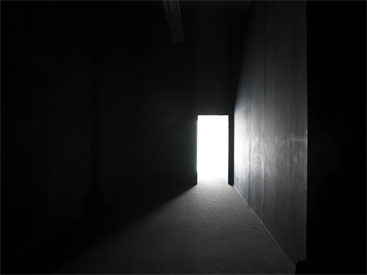
Born in 1965 at Laxou (FR).
Lives and works in Paris (FR).

1997-2006
Sound installation for five loudspeakers, with subtitles.
Year of Purchase: 2006
Dominique Petitgand’s work, which deals exclusively with sound, consists in recording people’s interviews, then cutting, splitting, and piecing their words back together by creating forms of dialog without answers, composed with music and sounds. These are paradoxical dialogs for a single interlocutor, which rely on variable modes of appearance of speech and on a precise economy of sound (namely thanks to silences) in order to create phonetic bodies with equivocal signifiers and signifieds. In that context, the installation La Cécité (Blindness) for five loudspeakers is based on the testimony of a woman talking about her childhood: making her way around a house in the dark. The work thus displays an extraordinary multiplicity of the types of stories which may emerge from discourse which is a priori banal.
Initially, this could be understood as a travelogue: a haptic nocturnal expedition, with the fingertips, from the bathroom to the dining room, told in the manner of a guided tour, with descriptions of things, smells, and sounds at each stage. It is an invitation to explore, in one’s memory, the sensory worlds and gaps which follow one another over the distance of a few meters in a familiar interior.1 But it is also a traumatic account which describes a childhood anxiety, relived as if under hypnosis, in view of a catharsis. A way of repressing the deep-seated, archaic fear of darkness, similar to the loss of consciousness. Indeed, this primitive fear functions for the audience as a paradoxical “intimate shared memory.” Now it’s a question of a narrative of initiation. It’s a philosophical itinerary through time and space. A setting forth into the darkness of neurosis and attainment of the light of reason, passing through edifying ordeals symbolized by this hesitant groping. The universal saga of the construction of individuality through fear, suffering, and willpower, as in the primitive versions of certain popular tales.2 On the other hand, the dull and disquieting rhythmic scansion which accompanies the storytelling through to the end, the evocation of a strange “hole,” and the unreal echoes of everyday objects bring to mind a supernatural tale. They constitute a sequence of sensory disjointedness at the heart of the everyday: familiar, yet never reassuring. Or yet, this could be a foreshadowing which concentrates the implicit ingredients of a crime story. What is the woman afraid of? Will she be able to reach the door? What is on the other side? There is a true suspense at work here, underscored by the treatment of sound and dramatic framing: the frightening darkness, the fragmented narrative, the hesitant memory, the invisible character of the danger. Finally, it’s a poetic tale: an allegory of lost childhood that is suddenly recovered, along with its confusion and its enchantment, its fears and its hopes. A melodic treatment of the story which, in order to express ineffable emotions, uses synesthetic correspondences, a tempo, rhythmic disruptions, tonalities, and transports us to a universe that is at once recognizable and emotionally unsettling.
Guillaume Désanges
1 The work of memory can be always likened to a journey. Solomon Veniaminovich Shereshevsky (the famous prodigy of photographic memory, who inspired Peter Brook’s production Je suis un phénomène) explained himself that in order to recall an infinite sequence of words, he only needed to mentally place them along a path familiar from his childhood which he then followed in order to pick them up and restore them.
2 See in particular the story of Red Riding Hood in its original versions, where the wolf offers the little girl a choice between the “path of pins” and the “path of needles” (two metaphors for the passage to puberty) in order to reach her grandmother.